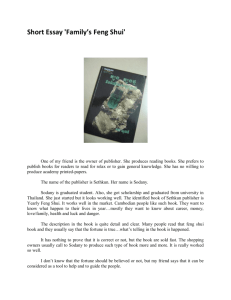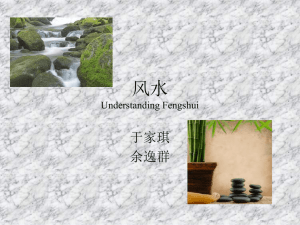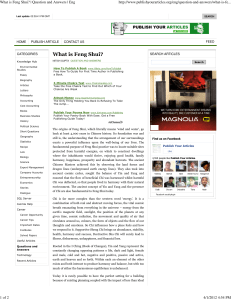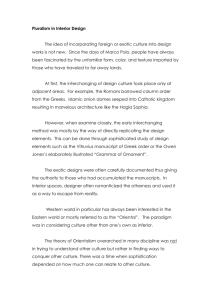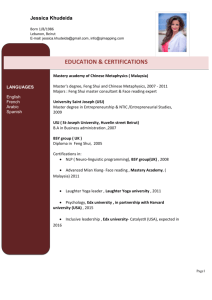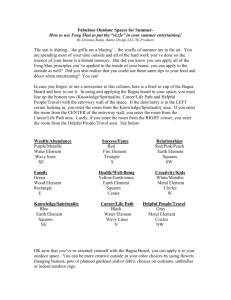Designing a Healthy Practice with Feng Shui
advertisement
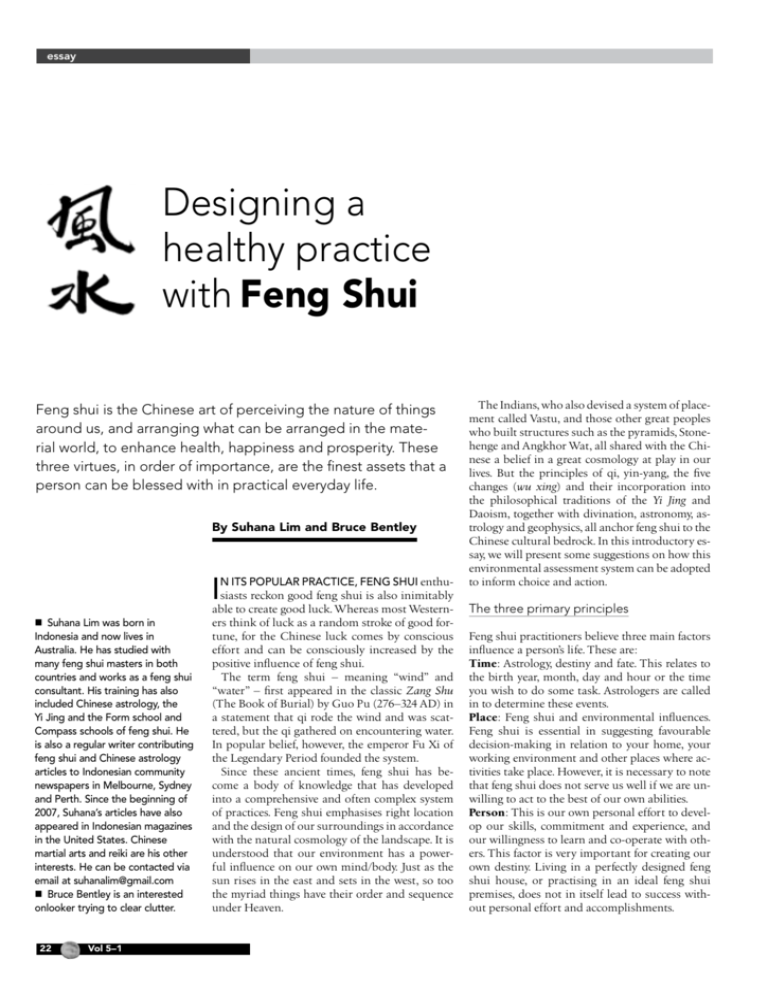
essay Designing a healthy practice with Feng Shui Feng shui is the Chinese art of perceiving the nature of things around us, and arranging what can be arranged in the material world, to enhance health, happiness and prosperity. These three virtues, in order of importance, are the finest assets that a person can be blessed with in practical everyday life. By Suhana Lim and Bruce Bentley I n Suhana Lim was born in Indonesia and now lives in Australia. He has studied with many feng shui masters in both countries and works as a feng shui consultant. His training has also included Chinese astrology, the Yi Jing and the Form school and Compass schools of feng shui. He is also a regular writer contributing feng shui and Chinese astrology articles to Indonesian community newspapers in Melbourne, Sydney and Perth. Since the beginning of 2007, Suhana’s articles have also appeared in Indonesian magazines in the United States. Chinese martial arts and reiki are his other interests. He can be contacted via email at suhanalim@gmail.com n Bruce Bentley is an interested onlooker trying to clear clutter. 22 Vol 5–1 n its popular practice, feng shui enthusiasts reckon good feng shui is also inimitably able to create good luck. Whereas most Westerners think of luck as a random stroke of good fortune, for the Chinese luck comes by conscious effort and can be consciously increased by the positive influence of feng shui. The term feng shui – meaning “wind” and “water” – first appeared in the classic Zang Shu (The Book of Burial) by Guo Pu (276–324 AD) in a statement that qi rode the wind and was scattered, but the qi gathered on encountering water. In popular belief, however, the emperor Fu Xi of the Legendary Period founded the system. Since these ancient times, feng shui has become a body of knowledge that has developed into a comprehensive and often complex system of practices. Feng shui emphasises right location and the design of our surroundings in accordance with the natural cosmology of the landscape. It is understood that our environment has a powerful influence on our own mind/body. Just as the sun rises in the east and sets in the west, so too the myriad things have their order and sequence under Heaven. The Indians, who also devised a system of placement called Vastu, and those other great peoples who built structures such as the pyramids, Stonehenge and Angkhor Wat, all shared with the Chinese a belief in a great cosmology at play in our lives. But the principles of qi, yin-yang, the five changes (wu xing) and their incorporation into the philosophical traditions of the Yi Jing and Daoism, together with divination, astronomy, astrology and geophysics, all anchor feng shui to the Chinese cultural bedrock. In this introductory essay, we will present some suggestions on how this environmental assessment system can be adopted to inform choice and action. The three primary principles Feng shui practitioners believe three main factors influence a person’s life. These are: Time: Astrology, destiny and fate. This relates to the birth year, month, day and hour or the time you wish to do some task. Astrologers are called in to determine these events. Place: Feng shui and environmental influences. Feng shui is essential in suggesting favourable decision-making in relation to your home, your working environment and other places where activities take place. However, it is necessary to note that feng shui does not serve us well if we are unwilling to act to the best of our own abilities. Person: This is our own personal effort to develop our skills, commitment and experience, and our willingness to learn and co-operate with others. This factor is very important for creating our own destiny. Living in a perfectly designed feng shui house, or practising in an ideal feng shui premises, does not in itself lead to success without personal effort and accomplishments. essay For many Chinese people, feng shui is as fundamental as the cycle of life and death itself. The system called “yin feng shui” deals with how to best secure advantages for the deceased, such as choosing a grave site in the most auspicious location possible. In Chinese thinking, the living also have much to gain from this, as their fortunes are bound up in the repose of the dead. It is a well-developed cultural belief that all members of a family lineage, both living and dead, share the same intrinsic qi. Therefore the experiences of the deceased influence the living – and their offspring into the future. “Yang feng shui” is concerned with the living. The natural processes that move nature and the universe coexist in similar fashion within the human body – a representation of the macrocosm on a remarkably small scale. The body, then, is the universe: The eyes are like the sun and the moon Shouting is like thunder Head hair is like plants and the forest Body hair is like grass Orifices are like caves Breath is like the wind Body contours are like mountains Fluids are like the rivers, streams and other water features. These associations are adaptations of a larger worldview, which also can be transposed to the microcosm of the practice. This has a metaphorical synergy with the imagery of the body. The building where you conduct your practice is to be seen as a metaphor for the body. For example in the home, different rooms have a corresponding association with the organs of the human body. These are: Wood is associated with the kitchen Fire is associated with the living room Earth is associated with the kitchen/dining room Metal is associated with the bedroom Water is associated with the bathroom Some other correspondences include: The entrance is the mouth. The windows are the eyes. The hallway is the throat. With this in mind, we can move on and create a therapeutic landscape. The location of a practice A pristine and pure environment is equivalent to a healthy body. A popular poem describes the ideal location for living as: “The wind is mild, the sun is warm, the water is clear and the vegetation lush.” In this modern world, such an ideal can rarely be achieved, however, the following recommendations can facilitate the best possible circumstances. When a feng shui practitioner analyses the location and surroundings of a building, some of the most important factors to consider are: n Patterns of the wind. The wind carries the qi and it is undesirable to be located in an area where the wind is too strong. Conversely, where there is no breeze or air movement, this identifies stagnation. n Observe the quality of the water or surrounding water bodies. Water holds the qi and so should be clean and pure. n Check the sunlight. Too much exposure to sunlight indicates excessive yang qi, causing people within the premises to be too active and suffer from insufficient rest and sleep. On the other hand, a dim location with poor sunlight contains more yin qi and leads people to be lethargic. n A feng shui-inspired practice: A Reception desk (with water feature) B Dispensary C Herbs D Display cabinet E Waiting area F Office desk G Practice table H Kitchen I Toilet J Qualifications & awards The principal considerations in choosing an auspicious location and building (in order of importance) are: 1. Do not occupy the highest or the lowest building in the area. In the highest, the building is subject to excessive winds and other strong weather elements. However, if your clinic is located in the lowest building in the vicinity, then The Lantern 23 essay ‘’ Green colour for the walls is best because it is the colour of the wood element and generates growth and renewal. This colour also benefits sick people the most... insufficient qi will be present. 2. The entrance to the building should not face a bigger, taller building, as this has the effect of blocking the qi. 3. It is ideal that at the back of the building, there is a larger building to act as the backbone to support your interests. 4. The flow of traffic in front of the building should be neither too fast nor too slow. Traffic jams indicate stagnation, although a pedestrian crossing or lights are positive forces because they can slow down in a natural way the qi that is otherwise likely to be moving too quickly. Traffic travelling too quickly will not allow the qi to gather or stay in the area, yet if the traffic is abnormally slow, this also indicates qi stagnation. 5. The building should have sufficient car parking, like a reservoir of qi that can then enter the building. 6. The name of the practice must be clearly visible – preferably on the yang side beside the entrance door. That means it should be to the right side when facing the entrance. 7. Avoid having heavy objects such as an electricity pole or other fixed objects in front of the practice. They have the effect of blocking the way in and reduce the amount of qi entering the building. Having said this, a parking meter is favourable and symbolises people contributing money to your business. Similarly, being located next to a bank or even an ATM machine is desirable, as well as practically helpful. 8.Avoid locating your practice at the head of a Tjunction. This location has excessive qi coming towards the building. However, this negative effect can be minimised when there are steps to the entrance, which elevate the doorway above the street level. A ba gua mirror can also be hung above the entrance to neutralise and disperse this excess energy by sending it in eight (all) directions. 9. Healthy trees and flora surrounding or in close proximity to the practice shows the environment is healthy. desk close to the telephone. The water element relates to communication and so enhances bookings. If this is difficult, then a glass bowel or a pot with water in it is suitable; noting that the water needs to be changed regularly to maintain clearness and quality. 5. Reduce pointy angles on all types of furnishings (including light fittings). These pointy corners emit negative energy (sha qi – killing/ life-destroying qi). If there is a pointy edge of the wall that angles towards a room or a place where a person is sitting, this for example, can be softened by placing a potted plant in front of the edge. Inside the practice 1. Try to minimise working with your back facing a door, as it is best to have something solid behind you. 2. The office desk should allow the practitioner to be seated with his or her back towards a solid surface, in order to provide strong protection. 1. Try to keep the practice open and neat. This allows the qi to move smoothly. Clutter is the most important thing to avoid. 2. Green colour for the walls is best because it is the colour of the wood element and generates growth and renewal. This colour also benefits sick people the most. 3. Healthy plants in the waiting room and elsewhere in the practice promote flourishing wood energy. The most feng shui-friendly varieties have rounded leaves. 4. Have a moving water feature on the reception 24 Vol 5–1 The waiting room 1. The chairs should all be positioned to face inwards and not towards the entrance door, as this fosters incoming qi as opposed to outgoing qi. 2. Maintain a light-filled and fresh airy practice so the sheng qi (life-giving qi) is abundant. The treatment room 1. Do not locate the treatment table in the “coffin position”, which has your patients’ feet facing the door. The newborn child ideally enters the world head-first and so we leave the world feet-first. 2. During treatment, when the patient is lying down, avoid having the top of their head towards a window, as this is where the qi is most active and they will find it hard to relax. When lying down, it is advised to have the patient’s head towards a solid wall, as it provides protection. 3. Try to minimise electronic equipment in the treatment room, because these types of instruments can make the movement of qi faster and lessen the opportunity for relaxation. Keep these to a minimum in the waiting room as well. For the practitioner The feng shui viewpoint, then, is a pragmatic one, and most of its language and observations find associations with Chinese medicine. By exploring these different paths of inquiry – feng shui with its consideration for our surroundings, and medicine with its care for the body – we can harmonise the environment on both sides of the skin.
